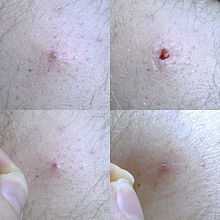Ingrown hair

Ingrown hair is a condition where hair curls back or grows sideways into the skin. The condition is most prevalent among people who have coarse or curly hair. It may or may not be accompanied by an infection of the hair follicle (folliculitis) or "razor bumps" (pseudofolliculitis barbae), which vary in size. While ingrown hair most commonly appears in areas where the skin is shaved or waxed (beard, legs, pubic region), it can appear anywhere. Anything which causes the hair to be broken off unevenly with a sharp tip can cause ingrown hairs.[1] Shaving is the leading cause, followed by waxing and tight clothing.[2]
Symptoms
Symptoms include rash, itching skin, hair which remains in spite of shaving, and infection and pus collecting under skin. The site of the ingrown hair will form a reddish, raised bump, similar in appearance to a pimple.[1]
Prevention
The simplest and most effective way to prevent ingrown hairs is to abstain from shaving and allow facial and body hair to grow out as normal.[3] When shaving, there are a few precautions that can be taken to prevent ingrown hairs including proper shaving techniques and preparation of the skin before shaving. When shaving, applying the proper amount of lubrication (in the form of shaving cream, gel, or soap) is important to prevent the hair from being forced underneath the surface of the skin. Also the application of too much force with a razor can contribute to hair that is cut shorter than the surrounding dermis.[4]
Treatment
There are many different treatments for ingrown hairs:
- They can be removed with tweezers (though this can be painful and might cause infections) or dislodged with a rotatable medical device for ingrown hairs.
- Some people who chronically get ingrown hairs use laser treatment or electrolysis to completely prevent hair growth.[5]
- There are many different products that prevent or cure ingrown hairs. Some are alcohol-based, while others are alcohol-free. For some, alcohol can cause skin irritation and thus alcohol-free products may be preferred.[6]
- Prophylactic treatments include twice daily topical application of diluted glycolic acid.[citation needed]
- Applying salicylic acid solution is also a common remedy for ingrown hairs caused by waxing or shaving.[citation needed]
Other treatments include putting a warm washcloth over the ingrown hair, shaving in a different direction, tweezing, exfoliating with facial scrubs, sponges, towels,[4] or creams containing acids, and ibuprofen or other non-steroidal anti-inflammatory drugs (NSAIDs).[citation needed]
References
- ↑ 1.0 1.1 Ingrown Hair: Causes, Symptoms, Treatments, Infections, Web MD.
- ↑ What causes an ingrown hair?, OnHealth.
- ↑ Can ingrown hairs be prevented?, OnHealth.
- ↑ 4.0 4.1 Ingrown Hair: Causes, Symptoms, Treatments, Infections page 2, Web MD.
- ↑ Removing an Ingrown Hair on the Face | LIVESTRONG.COM
- ↑ http://www.nafaa.org/ethanol.pdf
External links
- Ingrown Hairs from MedicineNet
- Ingrown Hairs from Weill Cornell Medical College
- Prevention of Ingrown Hair from Medicine Net / Hair Removal 1
- How to Remove an Ingrown Hair - article from wikiHow